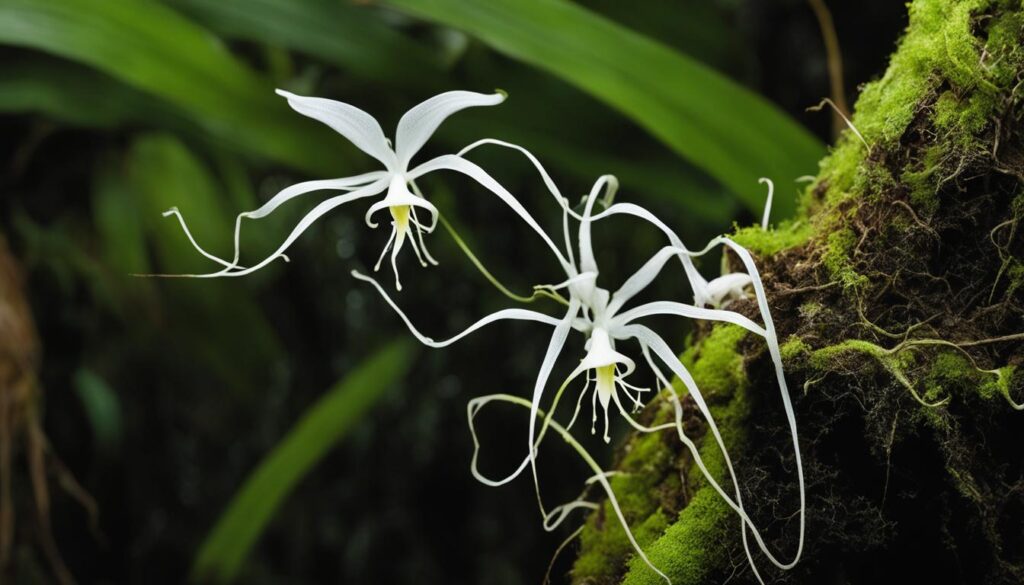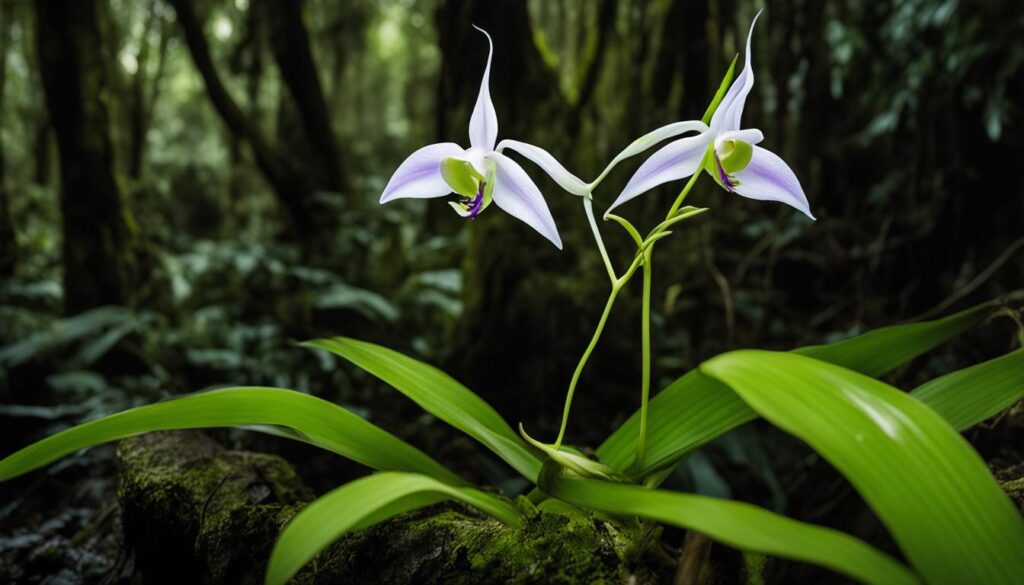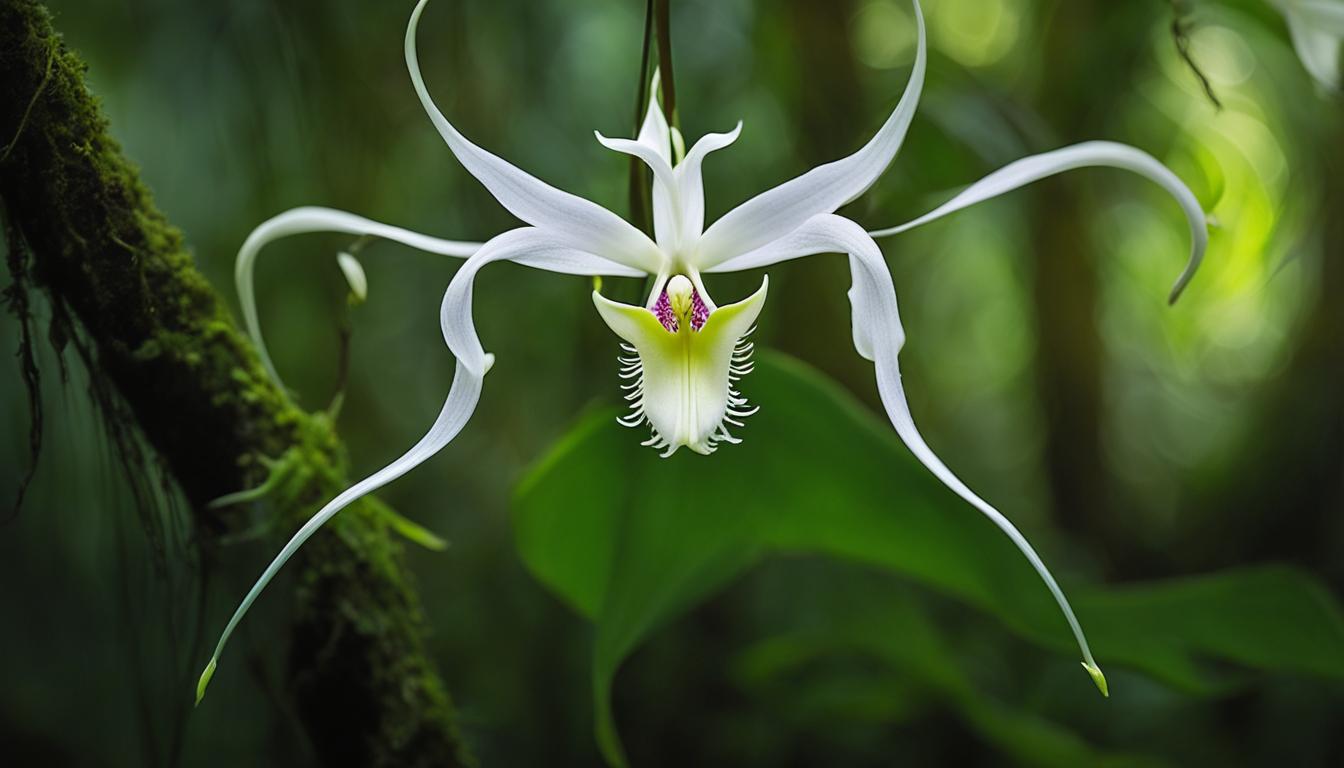Imagine venturing through the humid and enigmatic terrain of the Florida Everglades, where I’ve had the privilege to encounter one of the most ethereal beings on Earth, the Ghost Orchid.
This rare orchid holds me in awe with its delicate, aerial blooms, seemingly suspended in mid-air like a phantom of the forest. Its existence is a botanical curiosity, flourishing in the swamps of Florida and beyond, a whisper of white against the greens and browns of its environment.
Yet, it teeters on the brink of the unknown, an endangered species that demands our reverence and protection.
Key Takeaways
- The Ghost Orchid is an extraordinary and rare orchid known for its distinctive, levitating flowers.
- It predominantly thrives in the shaded, swampy regions of the Florida Everglades and is a source of great interest and study.
- As an endangered species, the Ghost Orchid faces threats that necessitate urgent conservation efforts.
- Its unique symbiotic relationship with fungi highlights a complex ecological system in balance.
- The orchid’s rarity and elusive nature continue to fuel scientific curiosity and draw enthusiasts to its mystical presence.
- The Ghost Orchid embodies the intricacies of nature, where survival and adaptation are interwoven with its very being.
- Preserving this botanical wonder is crucial for maintaining the biodiversity and ecological integrity of its native habitats.
The Ethereal Presence of the “Ghost Orchid”
As I wander through the dense, shaded forests of the Florida Everglades, my curiosity is enlivened by the pursuit of one of nature’s most enigmatic wonders – the Ghost Orchid.
This elusive orchid, with its spectral blooms, is a botanical masterpiece that thrives in the most unlikely of places. Unlike most flowers that beckon admirers with vibrant foliage, the Ghost Orchid is nearly invisible against the gnarled trees, camouflaged by its lack of leaves and its ghostly white flowers.
Its ability to flourish with chlorophyll-laden roots instead of leaves is a feat of evolution that captures not only the imagination but also the heart of conservationists.
The epiphytic lifestyle of the Ghost Orchid requires a delicate balance of rain and air nutrients – elements that are plentiful in its Floridian and Cuban habitats.
Here, amidst these landscapes, it sustains its existence, drawing life from the humidity of its environment.
To witness the ghostly flower is a rare occasion, one that often requires patience and a bit of luck.
The Ghost Orchid’s preference for the inaccessible crannies of the swamp and its limited blooming period renders it a gem among orchids, inspiring my own excursions and those of many others who hope to behold its delicate presence.
- Botanical masterpiece of rare beauty, patterned with spectral petals
- Remarkable ability to live as an epiphyte, absorbing nutrients from air and rain
- Symbol of biological mystery, eluding easy observation
- Incentive for ongoing conservation efforts due to its rare status
In truth, every encounter with a Ghost Orchid adds a layer of knowledge and appreciation towards these remarkable beings, and I find myself advocating for the preservation of their rare and wondrous kind.
| Ghost Orchid Feature | Description |
|---|---|
| Photosynthesis | Executed through roots that contain chlorophyll, making leaves unnecessary. |
| Lifestyle | Epiphytic growth on trees in humid, swampy environments. |
| Visibility | Typically camouflaged, making it difficult to spot. |
| Blooming Period | Only blooms under specific conditions and for a limited time. |
Deciphering the Biology Behind the Ghostly Flower
The Ghost Orchid, known scientifically as Epipogium aphyllum, harbors secrets of survival through its specialized biological framework.
This intriguing marshland inhabitant has perfected a set of environmental adaptation mechanisms to navigate its fragile existence as an endangered species in the shadowy wetlands.
In this exploration, I delve into the orchid’s particular adaptations and its intimate symbiotic relationships that are pivotal for its sustenance.
Adaptations of Epipogium aphyllum
In my observations, the Ghost Orchid demonstrates an incredible ability to adapt to its environment. Epipogium aphyllum forgoes traditional roots for a remarkable dependence on its tree bark perch, extracting moisture and nourishment directly from the air and occasional rainfall.
This adaptation negates the need for soil, setting the orchid apart as a marvel of botanical resilience.
This evolutionary strategy not only ensures its survival in challenging conditions but also gives it the spectral appearance that eludes so many who seek a glimpse of it.
Among the adaptations that I have found most striking in Epipogium aphyllum is the plant’s ability to thrive without green foliage, which in typical plant biology, plays a crucial role in photosynthesis.
Symbiosis: Orchid and Fungi Interactions
The crux of the Ghost Orchid’s existence lies within its critical symbiotic relationships, especially with certain fungi.
The intricacies of these connections highlight a network of cooperation essential for nutrient acquisition.
The mycorrhizal fungi form partnerships with the Ghost Orchid’s roots, facilitating an exchange of essentials that underscores the plant’s success in its ecological niche.
My findings suggest that this symbiosis is not merely beneficial but is, in fact, a lifeline for the endangered species, ensuring that both the orchid and the fungi may flourish.
The mutualistic relationship is a masterpiece of ecological harmony – one that I have observed to be impressively efficient in the transfer of nutrients in a habitat where such resources are scarce.

Studying the Habitat: The Ghost Orchid’s Swampy Abode
The allure of the Florida Everglades goes beyond its vast wetlands and rich biodiversity; it is also the nurturing ground for the elusive orchid known as the Ghost Orchid.
My journey into this humid haven reveals the complexity of conservation and the fragility of life in the balance. Here, I delve into the world of epiphytic living, where orchids defy the norm, thriving high above the swamp, anchored to the sturdy trunks of ancient trees.

Life in the Florida Everglades
Amidst the labyrinth of waterways and sawgrass prairies, the Everglades serve as a terrarium of sorts.
It’s a place where moisture perpetually hangs in the air, and the dappled light of the sun caresses the flora with warmth.
As an explorer of this region, I have seen firsthand the complex network of life that the Everglades supports, from the tiniest insect to the towering cypress trees.
The Rarity of Epiphytic Living
As I scale the rough bark, I witness the miraculous epiphytic existence of the Ghost Orchid. Clinging to the trees, their roots exposed to the elements, these orchids live in harmony with their host, exchanging life-sustaining nutrients for a perch amidst the canopy.
This rare lifestyle speaks volumes of adaptability and demands ongoing conservation efforts to protect these living jewels and their swampy abode.
In my heart, I carry the belief that with tender care and scientific dedication, these wonders of the natural world will flourish for generations to come.
The echo of this thought is evident in each breath of wind that courses through this paradise, whispering the ancient secrets of survival, resilience, and interdependence that define the Everglades.
Conservation Efforts for an Endangered Species
As a professional copywriting journalist, I take pride in bringing attention to the pressing issue of preserving endangered species.
There is perhaps no botanical curiosity quite as compelling as the Ghost Orchid, a symbol of the vital conservation efforts required to secure the future of our planet’s most vulnerable flora.
To maintain the ecological balance in the Florida Everglades, habitat restoration becomes not just a passion, but a necessity.
Joining forces with environmental organizations, I’ve witnessed firsthand the implementation of strategies designed to protect these fragile beings. Below, I’ve documented a set of initiatives that exemplify our commitment to this cause:
- Community Education Programs to increase public awareness about the importance of protecting endangered species like the Ghost Orchid.
- Partnerships with Local Conservation Groups that leverage their expertise in habitat restoration efforts.
- Scientific Research Funding to further our understanding of epiphytic orchids and their role within their ecosystems.
These efforts form the backbone of our fight against the erasure of such wonders from our world. To ensure clarity on our progress, here’s a snapshot of current restoration projects:
| Action | Scope | Impact |
|---|---|---|
| Ecosystem Rehabilitation | Everglades National Park | Revitalization of orchid’s native habitat |
| Captive Cultivation Programs | Botanical Gardens and Institutions | Propagation of Ghost Orchid to reduce wild-collection pressures |
| Invasive Species Management | Local and Regional | Protection of native plants and strengthening of biodiversity |
Ensconced within the swampy embrace of the Everglades, the Ghost Orchid remains an enduring emblem of the beauty and complexity of our natural world.
It is this allure, combined with the spirit of discovery, that ignites my desire to champion these conservation efforts. I hope that through my words, more will be inspired to join this noble endeavor – ensuring that the Ghost Orchid, and countless other endangered species, survive for generations to come.

Conclusion
As we draw our exploration to a close, the essence of the ghost orchid remains ever-entwined with the whimsy and wonder that defines it.
My experiences, weaving through the dense foliage of the Florida Everglades, only deepen my appreciation for this rare orchid and its role in an immensely complex ecosystem. Its ability to elicit awe and curiosity reveals much about our own connection to the natural world – a world where remarkable organisms such as the elusive orchid challenge our perceptions and underscore the importance of conservation.
Through advocacy and education, I find myself part of a community that treasures these botanical curiosities and champions their survival.
Our collective conservation efforts are integral to the legacy of such species, where every measure taken is a stride towards preserving the intricacies of life that the ghost orchid symbolizes.
Ongoing research and habitat protection wouldn’t just offer a lifeline to these orchids but also serve as a beacon of hope for countless other species whose stories are yet untold.
I am reminded that the ghost orchid’s narrative is not a solitary one, but part of a greater anthology of life that thrives in the shadows of the Everglades.
It’s a narrative woven of the threads of natural resilience, the fabric of ecological interdependence, and the pattern of human impact.
By safeguarding these wonders, we not only ensure the continuity of their existence but also honor the broader, vibrant mosaic of biodiversity that constitutes our planet – one extraordinary petal at a time.
FAQ
What is the Ghost Orchid?
The Ghost Orchid (Dendrophylax lindenii) is a rare and elusive orchid known for its unique, white, ghostly flower that appears to hover in the air since it lacks visible leaves. It is predominantly found in the Florida Everglades and some parts of Cuba. Due to its rarity and distinct appearance, it has captivated the interest of botanists, conservationists, and orchid enthusiasts alike.
Why is the Ghost Orchid so rare?
The rarity of the Ghost Orchid stems from its specific habitat requirements and the limited locations where it can thrive. It only grows in shaded, swampy environments, predominantly in the Florida Everglades, and has a complex ecological relationship with certain species of trees and fungi. Habitat loss, environmental changes, and the difficulties associated with cultivating the orchid contribute to its scarcity.
Where can you find the Ghost Orchid?
The Ghost Orchid can be found in the Florida Everglades as well as in some forests of Cuba. Within these regions, it typically grows high upon the trunks of certain trees in humid, swampy, and densely canopied areas, making it quite challenging to locate and observe in its natural setting.
How does the Ghost Orchid survive without leaves?
The Ghost Orchid has adapted to survive without conventional leaves, which are typically used for photosynthesis in plants. Instead, it has chlorophyll in its roots that allows it to photosynthesize and gather nutrients. This adaptation enables the orchid to live as an epiphyte, anchored to tree trunks and absorbing moisture and nutrients from the air and occasional rain.
What kind of symbiotic relationship does the Ghost Orchid have?
The Ghost Orchid engages in a symbiotic relationship with a specific type of mycorrhizal fungus. This relationship is essential for the orchid’s survival as the fungus helps the roots absorb nutrients and water from the surrounding environment. This mutualistic interaction is a key element of the orchid’s adaptation and success in its natural habitat.
Why are conservation efforts important for the Ghost Orchid?
Conservation efforts are critical for the Ghost Orchid because it is considered an endangered species due to its fragile habitat and specific growth requirements. The Florida Everglades, where it predominantly grows, faces threats such as climate change, development, and pollution. Protecting and restoring these habitats are necessary to ensure the survival of the Ghost Orchid and the broader ecosystem it supports.
What can individuals do to help conserve the Ghost Orchid?
Individuals can support conservation efforts by donating to organizations dedicated to preserving the Florida Everglades and other habitats of the Ghost Orchid. Educating oneself and others about the importance of these ecosystems, advocating for environmental protection policies, and participating in local conservation and restoration projects are also ways to contribute to the orchid’s preservation.


Leave a Reply